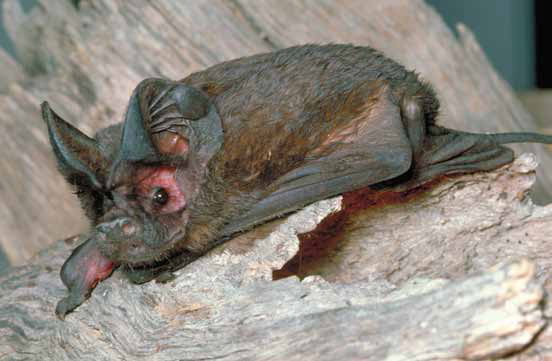Tadarida australis | Family: Molossidae | Conservation status: Not listed
Identification
The white-striped free-tailed bat is the largest of Australia’s free-tailed bats. It has a chocolate brown to black upper surface and is slightly paler below. As suggested by its name, it has an obvious white stripe along the side of the belly and onto the wings. Some individuals can be all black on the chest or have large, white patches. It has a large throat pouch and large, heavily wrinkled lips. The ears are separate, not joined across the top of the head as they are in some species of free-tailed bats. The call is a repetitive metallic “ting… ting… ting…” which is given as they fly high over the canopy. They also call when flying low but this call is inaudible to humans.
Habitat and distribution
The species is found across southern Australia except for Tasmania. It is an adaptable animal and occurs in forests, woodlands, grasslands, shrublands and even urban areas. It hunts either above the canopy, particularly along creek lines, or on the ground, scurrying around chasing crawling insects. Small groups of less than 20 animals roost in tree hollows. Single animals may be found roosting under bark, in buildings and in crevices in dead trees. Maternity roosts are much larger, sometimes numbering several hundred individuals. White-striped free-tailed bats migrate from southern Australia in winter, moving north and returning in spring.
Diet
High-flying moths are targeted by this species and its long narrow wings are well adapted for fast, high flight. It can travel up to 50 kilometres from its roost in search of food. Some researchers report that it will also scurry around on the ground chasing ground-dwelling insects such as beetles, bugs, grasshoppers and ants. They are able to do this by folding their wings away neatly so that their forearms are free, retracting their tail membrane and scampering around on their thumbs and hind feet. They have also been observed flying into water while in pursuit of prey.
Reproduction
Breeding begins in late August, the females are pregnant in spring and early summer and give birth to one young between mid-December and late January. It is not known if sperm is stored or embryo development is delayed over winter. White-striped free-tail bats have an asymmetrical uterus, with only one horn, so produce one young at a time. Young are weaned by May and the females are sexually mature by August, in time for the next breeding season.
Threats
Land clearing and disturbance or removal of roost sites in urban areas can cause local extinction of a population. Frequent wildfire can also degrade the habitat of bats, damaging or destroying nest hollows.
Management actions
Maintenance of reserves and urban bushland is important for the persistence of this species near human activity. Identification and protection of important roost sites in an area can protect the population when land is being developed.
Quick Bat Facts!
Size (head and body length) : 85 – 100 mm
Size (tail) : 40 – 55 mm
Weight : 25 – 40 g
Habitat : Southern Australia in forests, woodlands, shrublands, grasslands and urban areas.
Diet : Flying and ground invertebrates including moths, beetles, grasshoppers and ants. Hunts high above the canopy or scampers on the ground to catch its prey.
Reproduction : Breeding starts in August, young are born December – January and weaned by May. They are able to breed in their first year of life.
[SOURCE: Mammals of the Avon Region, Mandy Bamford, Rowan Inglis and Kate Watson, 2009, pp.104-105]
[Image credit: Parks Victoria]


